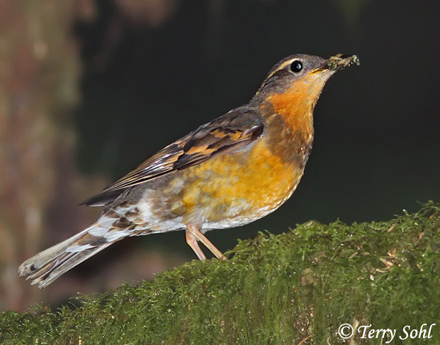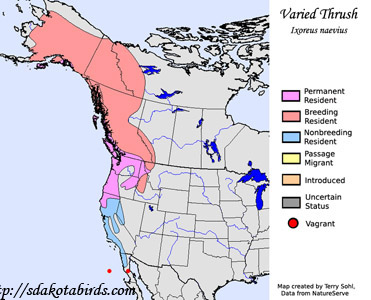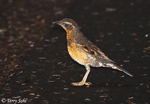| Length: 9 inches | Wingspan: 14 to 16 inches | Seasonality: Winter |
| ID Keys: Orange throat, breast and eyebrow, black necklace, orangish wing-bars. | ||
 The Varied Thrush is normally a bird of the Pacific Northwest,
western Canada, and Alaska. In winter, however, some birds wander widely,
reaching South Dakota and occasionally even reaching the East Coast of the
U.S. They generally spend the majority of their time on the ground, and
can be difficult to spot as they forage through dense forest
undergrowth. Their haunting calls are often heard echoing through the
forest, however.
The Varied Thrush is normally a bird of the Pacific Northwest,
western Canada, and Alaska. In winter, however, some birds wander widely,
reaching South Dakota and occasionally even reaching the East Coast of the
U.S. They generally spend the majority of their time on the ground, and
can be difficult to spot as they forage through dense forest
undergrowth. Their haunting calls are often heard echoing through the
forest, however.
Habitat: Generally breeds in wet, dense coniferous forest near the coast. During migration and in the winter, still prefers dense coniferous forest, but can be found in other areas with thick undergrowth.
Diet: Primarily feeds on insects and spiders in the summer, along with earthworms and snails. Primarily feeds on fruit and berries in the winter, along with some seeds.
Behavior: Often forages on the ground, walking or hopping along in its search for food, sometimes using its bill to look under leaves and other debris. Will also forage up in the foliage of trees and shrubs.
Breeding: Non-breeder in South Dakota
Song: Long breathy whistled note. At a distance, it almost sounds like distant squeaky car brakes to me!
Migration: Summers from the Pacific Northwest of the U.S., up through western Canada and most of Alaska. Usually winters near the western coast of Canada or the western tier of U.S. states, although some wander widely in the winter and may even reach the east coast of the United States.
Interactive eBird map: Click here to access an interactive eBird map of Varied Thrush sightings
Similar Species: American Robin
Feeders: Will sometimes attend feeders for fruit and some seeds.
Conservation Status: Widespread and fairly common throughout its range. Numbers may be decreasing somewhat, but there is currently no threat to overall populations. The IUCN considers the Varied Thrush to be a species of Least Concern.
Further Information: 1) USGS Patuxent Bird Identification InfoCenter, Varied Thrush
2) Audubon Field Guide - Varied Thrush
Photo Information: June 28th, 2011 - Ecola State Forest in coastal Oregon - Terry Sohl
| Click on the map below for a higher-resolution view |
 |
| South Dakota Status: Rare winter visitor. |
Additional Varied Thrush Photos
Click for a higher-resolution version of these photos


